

Project «Voices of Jewish settlements. Vitebsk region.»פיתוח קשרי התרבות בין העמים של ישראל ובלרוס
|
|---|
Website search |
|
MainNew publicationsContactsSite mapVitebsk regionMogilev regionMinsk regionArkady Shulman
|
Vladimir ShragaTWO HOURS IN DRUYA Former Jewish shops in the main square.
Former Jewish shops in the main square.
It is on the edge of Belarus. Across the river are Latvian fields covered with snow. Druya. It used to be a town and now it is a border village. At the entrance to the village one can see a bus intersection, which used to be the central square. There are two two-storey houses which are left from that period – downstairs there used to be shops, which belonged to Jews, the owners lived on the second floor. Today these houses are both abandoned, standing like two old friends. The authorities are planning to demolish them. 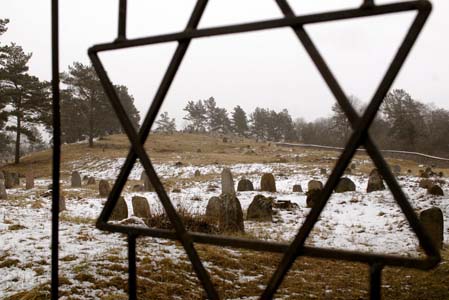 Magen David on the gate of the Jewish cemetery in Druya.
Magen David on the gate of the Jewish cemetery in Druya.
In the afternoon more and more people gather at the intersection – they are waiting to buy hens, which will be brought soon. I see a middle-aged woman and we start taking about the old days. “More than half of the population here used to be Jewish”, - says Mrs. Klenovski, - “They were engaged in trade, while some of them were craftsmen or farmers. The town was very clean; streets were cobbled. What do we have now? Just dust carried around by the wind.” 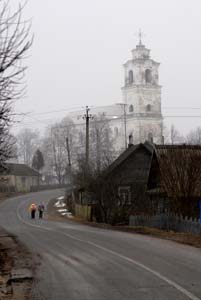 The road
The roadto the Catholic church. 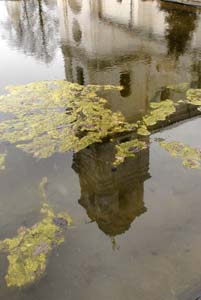
She recalled the old days. “Druya was close to Drissensky (Verkhnedvinsky) region, which belonged to the Soviet Union. So, here, on this side of the Dvina River people were celebrating a holiday – they were dressed in festive clothes, dance and sang. Across the river there was a commune and women were plowing land, trying not to look at the opposite bank. In 1939 the Red Army arrived in Druya. Many of my relatives were exiled to Siberia. We had a neighbor, a woman, who was ecstatic when the Soviet Army came – she took out a red headscarf, tied it to a long stick and ran around yelling: “The right power has come!” Later she went insane from the life, which was brought about by “the right power”.  Old stones of the Jewish cemetery.
Old stones of the Jewish cemetery.
Soon we received another wound: the war. I remember the first bombing at the beginning of the war. My mom and I were walking in a field and abruptly stopped by awful noise. We saw planes and falling bombs. And we were in that huge field with no place to hide. Running was pointless. We just flopped into a furrow, I lay as close to my mother as I could. So we lay until the bombing was over.” Old people from Druya remember all the epochs which the 20th century holds. We can only imagine what kind of memories is kept by the ancient stones of the Jewish cemetery in Druya. Matseivas (tombstones) – some of them are 200 or 300 years old – stick out of the ground, climb a small hill, press themselves against pines, as if trying to be close to something that is still alive. The old stones are surrounded with a new fence, set up by the people who originated from Druya. After the war almost no one was left to be buried in the Jewish cemetery. 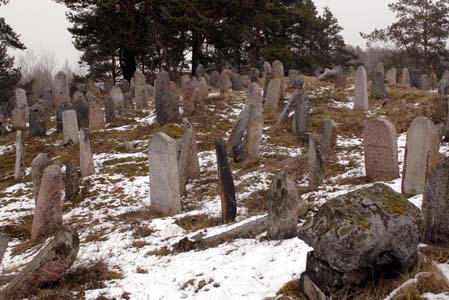 Old stones of the Jewish cemetery.
Old stones of the Jewish cemetery.
“The Jews were shot here, hear the Druika”, - recollects Mrs. Klenovski. – “It was a horrible sight. There was a machine gunner on the bridge. Many Jews were brought from neighboring villages. Everyone was taken to the river, even babies. The air all around the town was permeated with gunpowder smell. Then, since there was not enough space here, the bodies were transported to the cemetery and buried. The ground was moving for three days that followed and the water in the Druika was red. Very few were lucky to save themselves.” Those, who did escape, left this place soon after the war. Today there is a memorial on the sight of the execution, only broken bricks can be seen at the spot where the synagogue was once located. Nothing else reminds us that it used to be a Jewish town. 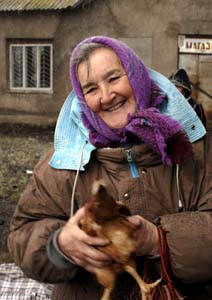 Mrs. Klenovsky.
Mrs. Klenovsky.
If a stranger, a mere traveler, takes a look at the village, they will not be able to discern the drama, which took place in its streets. Time erases everything. A traveler would look at puddles and see only intricate reflections in the water. He would see the main street climbing up the hill and a Catholic church somewhere in the distance. It hangs mysteriously over tiny houses like a ghost. Then one can see a horse, lazily dragging a carriage. This is real: the church and the horse – they do exist. The church has been here for 350 years. It contains some special silence. The past of Druya as a town makes a tremendous contrast with its present as a village. Perhaps, due to this contrast the place still somehow retains its spirit of a shtetl… If Jews lived here today, they would still be on their horse carriages, queue for hens in the square and talk about the past. It would be a quiet life. But something has broken, something has gone wrong if the stone houses have become decrepit, if the main square has become a bus intersection, if there is no one to read a remembering prayer on the hill of the Jewish cemetery. |
|||
|
|
Jewish settlements in Vitebsk regionVitebsk • Albrehtovo • Babinovichi • Baran • Bayevo • Begoml • Beshenkovichi • Bocheikovo • Bogushevsk • Borkovichi • Braslav • Bychiha • Chashniki • Disna • Dobromysli • Dokshitsy • Druya • Dubrovno • Glubokoye • Gorodok • Kamen • Kohanovo • Kolyshki • Kopys • Krasnopolie • Kublichi • Lepel • Liady • Liozno • Lukoml • Luzhki • Lyntupy • Miory • Obol • Oboltsy • Orsha • Osintorf • Ostrovno • Parafianovo • Plissa • Polotsk • Prozorki • Senno • Sharkovshina • Shumilino • Sirotino • Slaveni• Smolyany • Surazh • Tolochin • Ulla • Verhnedvinsk • Vidzy • Volyntsy • Yanovichi • Yezerishe • Zhary • Ziabki • |
Main |
New publications |
Contacts |
Site map |
Vitebsk region |
Mogilev region |
Minsk region |